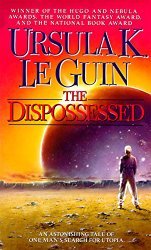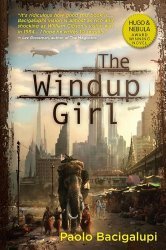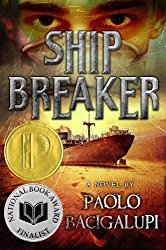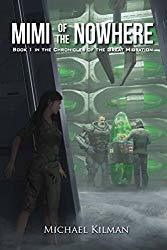Treesong's Blog: Treesong on Goodreads - Posts Tagged "dystopian"
Book Review: The Dispossessed by Ursula K. Le Guin

The basic premise is fairly simple. The Tau Ceti star system is home to two twin planets, Urras and Anarres. Urras is a verdant, hospitable world that has been inhabited by humanoid life for millennia. Anarres, on the other hand, is a sparsely populated desert world that was settled two hundred years ago by revolutionary anarchists. Aside from a single freighter that periodically makes the trip, the two worlds — archist Urras and anarchist Anarres — are completely isolated from each other. The story starts with the first person traveling from Anarres to Urras since the revolution that lead to the settlement of Anarres.
What makes The Dispossessed a remarkable work of literature is the ease with which it explores a wide range of fascinating and important themes and topics through the lens of a compelling plot and cast of characters. Many books have one or more of these elements — compelling characters, compelling plot, interesting political ideas, interesting scientific ideas, interesting philosophical ideas, etc. The Dispossessed combines all of the above into an impressively cohesive and compelling narrative.
The main obvious theme is the role of government in human societies. The simplest explanation of the plot is that it’s a utopian tale exploring what it would be like if an anarchist (specifically anarcho-syndicalist) society had an entire world on which to develop its own social institutions and culture. This is contrasted with the realities of the archist (a.k.a. statist) world. Urras is dominated by two nation-states — the capitalist (“propertarian”) A-Io and the communist Thu. These two nation-states are drawn into a proxy war that serves as a fairly transparent (but creatively executed) analogy for the real-world conflict in Vietnam and the Cold War generally.
There are, however, many additional nuances to the setting and story that go beyond the role of government. Gender, sex, and sexuality are explored at some length, contrasting the patriarchy and possessive of A-Io with the gender equality and sexual liberation of Anarres. Physics and philosophy are also discussed at great length because the main character, Shevek, is a theoretical physicist and philosopher who is searching for a unified theory of time and space similar to the one that real-world physicists are searching for.
Part of what makes The Dispossessed such an exceptional novel is its utopian realism. The dichotomy between Urras and Anarres initially seems quite simple — the dystopian “propertarians” versus the utopian anarchists. As the novel progresses, however, the narrative explores the strengths and weaknesses of both worlds in a complex and realistic manner. Anarres clearly has the more liberatory society, but its emphasis on mutual aid ironically leads to an overemphasis on social approval and acceptance which can discourage innovation and independent thinking. Urras is clearly a troubled propertarian society, but their world has so much more material wealth and abundance of living creatures. Shevek has many interesting and rewarding experiences on Urras, even though A-Io’s institutions and culture are ultimately contrary to his values.
The Dispossessed offers an exciting exploration of life’s nature and purpose. The depth and thoughtfulness of this exploration is rare both in fiction and reality. It’s an exciting (and at times harrowing) journey through many questions about life, love, the world, the cosmos, and everything in between. I highly recommend this book to anyone and everyone. I’m also glad to see that others have already developed curricula related to The Dispossessed. This is a book that should be taught in literature, philosophy, and other classes right along with other great classics of utopian and dystopian fiction.
For this and other reviews by Treesong, visit treesong.org.
Published on September 19, 2015 17:50
•
Tags:
anarchism, book-review, dystopian, sci-fi, speculative-fiction, utopian
Book Review: The Windup Girl by Paolo Bacigalupi

This novel works so well on so many levels. I found the surreal post-apocalyptic setting and the colorful cast of character compelling from the very beginning. As the story progressed, it became clear to me just how fascinating, complex, and meaningful this story is. The technology, ecology, economy, culture, and characters all intersect and interact to create plots and character development that possess a rare combination of both depth and urgency. If I had more spare time, I would have been tempted to read the entire novel in a single sitting. I'm glad I didn't, though, because there is too much good material here to digest in a single sitting. Fully appreciating the setting, the characters, and the meaning behind it all takes time -- but it's well worth the effort.
The story explores some of the extremely negative potential outcomes of bioengineering. Proponents of bioengineering might very well have a knee-jerk reaction, assuming that the entire novel is just a fear-based screed against the dangers of bioengineering. However, Bacigalupi's exploration of the topic is surprisingly nuanced and introspective. Yes, there are horrors -- an endless parade of corporate-engineered plagues, bizarre bioengineered creatures, and so on. But there are also curiosities and wonders. The author's presentation of bioengineered horrors is not so much a critique of biengineering itself as it is a critique of the individuals and corporations that would apply the technology of life to the ruthless pursuit of profit and power.
The exploration of human-caused global warming is a less central focus of the novel, yet still a major thread in the weaving of this complex narrative. As an author with an emphasis on climate fiction, human-caused global warming tends to be at the center of the plot of many of my stories. Bacialupi, however, chooses to incorporate it as prominent part of the setting rather than making it the driving force behind the advancement of the plot. This story takes place in a world that is suffering from the consequences of global warming and the end of the fossil fuels era. Simply presenting this as a fact of the setting rather than making it a turning point of the plot actually places a quiet but powerful emphasis on his presentation of the future realities of global warming. It's just a given; in the future, no one is contesting the existence or effects of global warming. It's just a reality that everyone has to deal with, reflected in many aspects of their society -- from transportation to energy sources and beyond.
The Windup Girl also features several explorations of how race and ethnicity impact identity and basic survival in times of upheaval. As a person of European ancestry living in the United States, it was very interesting (and illuminating!) for me to see the pale-skinned, blue-eyed "farang" (white) characters portrayed as foreign and dangerous. That may sound offensive to some people, but I actually found it to be quite appropriate and a very well-written aspect of the plot and character development. It was also interesting to see the relationships between the native Thais, the Malaysian Chinese, the Japanese, and the bioengineered "windups" or "New People".
There are some books -- especially in the realm of speculative fiction -- that I would only recommend to certain audiences. Zombie fiction is for zombie fans; romance novels are for romance fans; and so on. The Windup Girl, however, is a novel that I would recommend to everyone alive today in the early twenty-first century. Some of the technological elements and drastic changes that have taken place in society will seem strange to readers who don't usually read speculative fiction. However, the importance of the themes explored -- and the artful and compelling way in which they are explore -- makes this novel a worthwhile read for everyone who cares about the future of life on this planet!
Published on October 04, 2015 16:09
•
Tags:
biopunk, cli-fi, climate-fiction, dystopian, post-apocalyptic, sci-fi, speculative-ficiton
Book Review: Ship Breaker by Paolo Bacigalupi

Ship Breaker is set in a distant future where the world has succumbed to the ravages of climate change and the resulting societal collapse. The main character is a young scavenger named Nailer who lives on the beach and spends his days crawling around in old shipwrecks, ripping out copper wire and any other valuables he can find for his crew to sell. His whole world is turned upside down when he comes across the salvage opportunity of a lifetime which turns out to be the start of an exciting adventure.
I thoroughly enjoyed Ship Breaker for several reasons.
The novel works well as young adult (YA) fiction. It addresses many of the most common YA themes -- family problems, friendship, betrayal, coming of age, young romance, etc. It touches all of the familiar bases without being formulaic or overly predictable. This depth of character and plot is greatly facilitated by a very well-developed setting. The setting is dystopian, but it's not the vague and generic dystopia portrayed in some YA fiction. It's a complex, gritty, realistic world that is revealed to us bit by bit through the eyes of the main character. Vivid description of this setting and the characters who populate it make this story stand out from the rest of the genre. There are several moments of violence that may be too much for really young or sensitive readers, but it all felt very appropriate to the plot and was treated very seriously and realistically rather than being glorified or sanitized.
I also like the fact that this novel works well for adults. Some YA ficton is so caught up in melodramatic genre tropes that it becomes unreadable for anyone who's grown out of their angsty teen phase. Ship Breaker leans in the opposite direction -- an excellent story that happens to include some young characters at the center of the action. The author has done a great job of crafting a tale that's accessible to young adults but mature and robust enough for older readers.
Of course, as a climate fiction author myself, one of my favorite parts of the novel is the way that it addresses climate change. The story takes place in a future setting where sea level has risen considerably, drowning coastal cities and contributing to the collapse of society as we know it. Most of the book doesn't explicitly talk about climate change, but the whole setting is a constant reminder of the consequences of our actions if we continue along our current emissions trajectory. This is a great way to get the message across without explicitly emphasizing it. There's also a point, though, where characters do explicitly discuss climate change and how their actions may contribute to it. I felt that it was handled very well -- letting the characters talk about it at a natural moment for them without having it seem forced or heavy-handed.
I would definitely recommend Ship Breaker both to young adult readers and to any older adults with an interest in climate fiction, dystopian fiction, biopunk, or any related genres. Paolo Bacigalupi is an excellent author, and I'm looking forward to seeing the film adaptation of Ship Breaker as soon as it comes out.
Published on March 01, 2017 13:32
•
Tags:
cli-fi, climate-fiction, dystopian, global-warming, sci-fi, science-fiction, young-adult
Book Review: Mimi of the Nowhere by Michael Kilman

This novel is definitely for a particular sci-fi audience that enjoys a hypertech setting full of walking cities, technological wonders that stave off the effects of aging and illness, powerful mech suits, and more. It's not for a casual reader looking for a realistic tale about the future of climate change. On the flip side, it does insert a bit of climate change framing into the sort of post-apocalyptic tale that might otherwise just blame the sorry state of the world on "The War" or some other cataclysm.
One of my favorite things about this novel is the way that it explores the class divides within the city of Manhasten. The main character, Mimi, is essentially homeless. She has a small spot in the lower levels where she sleeps and stores some personal effects, but no actual home. The people on the upper levels are wealthy, and their wealth allows them to buy access to technological advancements that render them more or less immune to diseases and aging. This serves as a metaphor for the way in which wealth in real life buys the wealthy access to medical care and longer lifespans.
One big downside for me is that the novel didn't actually do much to explore the climate change framing. This isn't actually much of a downside if you're just in the mood for some far-future tales of walking cities and mysterious telepaths and aren't too concerned about climate change themes. But since I read almost exclusively climate fiction, I was left wanting more. Maybe future novels in the series will address the origins of this surreal "walking cities roaming across a desolate landscape" setting.
On the whole, I'd say that Mimi of the Nowhere was an interesting read. Since it doesn't center around climate, I wouldn't recommend it specifically for people who are looking for tales about what the world will be like when the world is ravaged by climate change. But if you have an interest in walking cities, sci-fi class critiques, telepathic secret societies, hypertech sci-fi novels centered or primarily around women characters, novels that reference the climate crisis tangentially, or all of the above, this is the novel for you.
Published on February 04, 2020 17:00
•
Tags:
book-review, cli-fi, climate-fiction, dystopian, post-apocalyptic, walking-cities
Treesong on Goodreads
Treesong is an author, talk radio host, community organizer, and Real Life Superhero. His main writing focus is climate fiction ("cli-fi"), but he is also a lifelong fan of science fiction, fantasy, a
Treesong is an author, talk radio host, community organizer, and Real Life Superhero. His main writing focus is climate fiction ("cli-fi"), but he is also a lifelong fan of science fiction, fantasy, and related genres.
This blog features Treesong's occasional musings on his writing, the writing of other authors, and anything else that comes up along the way. ...more
This blog features Treesong's occasional musings on his writing, the writing of other authors, and anything else that comes up along the way. ...more
- Treesong's profile
- 40 followers



